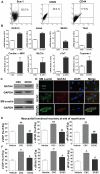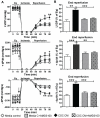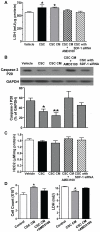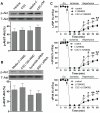Sca-1+ cardiac stem cells mediate acute cardioprotection via paracrine factor SDF-1 following myocardial ischemia/reperfusion
- PMID: 22195033
- PMCID: PMC3240662
- DOI: 10.1371/journal.pone.0029246
Sca-1+ cardiac stem cells mediate acute cardioprotection via paracrine factor SDF-1 following myocardial ischemia/reperfusion
Abstract
Background: Cardiac stem cells (CSCs) promote myocardial recovery following ischemia through their regenerative properties. However, little is known regarding the implication of paracrine action by CSCs in the setting of myocardial ischemia/reperfusion (I/R) injury although it is well documented that non-cardiac stem cells mediate cardioprotection via the production of paracrine protective factors. Here, we studied whether CSCs could initiate acute protection following global myocardial I/R via paracrine effect and what component from CSCs is critical to this protection.
Methodology/principal findings: A murine model of global myocardial I/R was utilized to investigate paracrine effect of Sca-1+ CSCs on cardiac function. Intracoronary delivery of CSCs or CSC conditioned medium (CSC CM) prior to ischemia significantly improved myocardial function following I/R. siRNA targeting of VEGF in CSCs did not affect CSC-preserved myocardial function in response to I/R injury. However, differentiation of CSCs to cardiomyocytes (DCSCs) abolished this protection. Through direct comparison of the protein expression profiles of CSCs and DCSCs, SDF-1 was identified as one of the dominant paracrine factors secreted by CSCs. Blockade of the SDF-1 receptor by AMD3100 or downregulated SDF-1 expression in CSCs by specific SDF-1 siRNA dramatically impaired CSC-induced improvement in cardiac function and increased myocardial damage following I/R. Of note, CSC treatment increased myocardial STAT3 activation after I/R, whereas downregulation of SDF-1 action by blockade of the SDF-1 receptor or SDF-1 siRNA transfection abolished CSC-induced STAT3 activation. In addition, inhibition of STAT3 activation attenuated CSC-mediated cardioprotection following I/R. Finally, post-ischemic infusion of CSC CM was shown to significantly protect I/R-caused myocardial dysfunction.
Conclusions/significance: This study suggests that CSCs acutely improve post-ischemic myocardial function through paracrine factor SDF-1 and up-regulated myocardial STAT3 activation.
Conflict of interest statement
Figures












References
-
- Uemura R, Xu M, Ahmad N, Ashraf M. Bone marrow stem cells prevent left ventricular remodeling of ischemic heart through paracrine signaling. Circ Res. 2006;98:1414–1421. - PubMed
-
- Lim SY, Kim YS, Ahn Y, Jeong MH, Hong MH, et al. The effects of mesenchymal stem cells transduced with Akt in a porcine myocardial infarction model. Cardiovasc Res. 2006;70:530–542. - PubMed
Publication types
MeSH terms
Substances
Grants and funding
LinkOut - more resources
Full Text Sources
Medical
Research Materials
Miscellaneous

